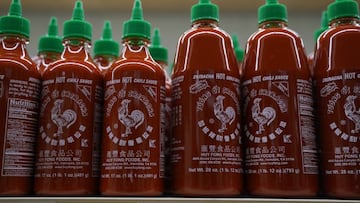Why can’t I find Sriracha hot sauce at the supermarket?
This is a shortage of the popular, multi-purpose spicy sauce due after complaints were submitted to California’s Department of Public Health.

Consumers may have noticed that there are fewer bottles of Sriracha hot sauce on the shelves of their local supermarket than usual. And it is looking unlikely that empty shelves will be restocked anytime soon. Due to a ruling by health officials, distribution of the sauce has been halted temporarily.
Other news
- The US has much lower gas prices compared to much of the world
- Average price of gas in US nears $5
- Why is Goodyear recalling the G159 tires 19 years after the last ones were manufactured?
What is Sriracha sauce?
Sriracha sauce, (sometimes called Rooster sauce as it features a rooster on the bottle), is a bright red, spicy Asian-style sauce made from sun-ripened red chili peppers, garlic, distilled vinegar, salt and sugar. It is slightly sweeter than other hot sauces such as sweet chili sauce or peri-peri sauce and served as a condiment in Thai, Vietnamese and Chinese cuisine throughout the United States but also used in a variety of other ways to give noodles, soup and other dishes an extra kick.
It is named after Sri Racha, a town on the east coast of the Gulf of Thailand, about 120 km southeast of Bangkok. It is believed that the sauce was created in the mid-1970s by Vietnamese immigrant David Tran, who started making it in large quantities and selling it to the Asian community and restaurants in Los Angeles’ Chinatown after he moved to the US in 1979.
The popularity of Sriracha sauce and hot chili sauces in general has skyrocketed in the US with a market turnover of $2.17 billion last year and projected to rise to $2.89 billion in 2022, according to Fortune Business Insights. There are several brands of the sauce but the most popular in the US is manufactured by Huy Fong Foods, which is owned by David Tran, now 77 years of age. More than 10 million bottles of Huy Fong Foods Sriracha are sold every year, with the company’s revenue exceeding $150 million in 2019. It was widely available in three bottle sizes: 9 oz., 17 oz., 28 oz. and 8.50 lbs - until recently.
Going to the source of the Sriracha success story https://t.co/DIbvZ3hdoK
— Huy Fong Foods (@huyfongfoods) November 14, 2019
Why has Sriracha sauce become scarce?
The Huy Fong Foods factory is located in the Irwindale industrial estate, just off the 10 Freeway in southern California. Late summer is chili grinding season when truckloads of chili peppers are sorted, cleaned and ground prior to a 15-day fermentation process. It’s an event held over several weekends and the general public are free to visit to watch the process in guided tours of the facility.
Related stories
But health concerns have been ongoing for a number of years. In October 2014, Irwindale residents complained of a foul, noxious smell emanating from the Huy Fong Foods factory during the chili-grinding phase. There were reports of members of the public suffering irritation to their eyes and throat as well as asthma sufferers complaining of serious discomfort - believed to be related to high levels of capsaicin, a chemical compound found in chilis and a proven irritant, in the air.
There are two factors which have affected Sriracha sauce production this year - the first, according to the company, is the drought which hit chili harvesting in Mexico. Ad the second is the new rules put in place by the California Department of Public Health concerning fermented and microbial food products which must be inspected and approval before they can be shipped out. That means more delays for Huy Fong Foods, who cannot distribute their famous sauce until it has been inspected, then bottled - it is estimated that the process could be held back until January 2023.

